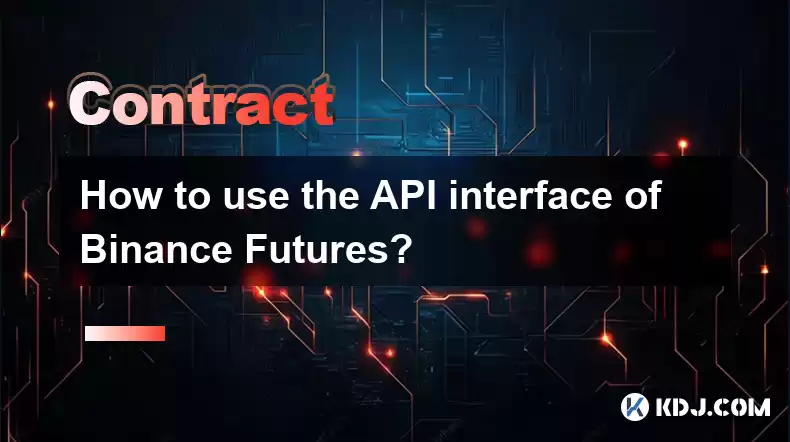-
 bitcoin
bitcoin $87959.907984 USD
1.34% -
 ethereum
ethereum $2920.497338 USD
3.04% -
 tether
tether $0.999775 USD
0.00% -
 xrp
xrp $2.237324 USD
8.12% -
 bnb
bnb $860.243768 USD
0.90% -
 solana
solana $138.089498 USD
5.43% -
 usd-coin
usd-coin $0.999807 USD
0.01% -
 tron
tron $0.272801 USD
-1.53% -
 dogecoin
dogecoin $0.150904 USD
2.96% -
 cardano
cardano $0.421635 USD
1.97% -
 hyperliquid
hyperliquid $32.152445 USD
2.23% -
 bitcoin-cash
bitcoin-cash $533.301069 USD
-1.94% -
 chainlink
chainlink $12.953417 USD
2.68% -
 unus-sed-leo
unus-sed-leo $9.535951 USD
0.73% -
 zcash
zcash $521.483386 USD
-2.87%
How to use the API interface of Binance Futures?
Binance Futures' API enables programmatic trading, requiring secure API key handling, endpoint selection for desired functions (trading, account info, market data), JSON response parsing, and robust error/rate limit management for secure, efficient interaction.
Mar 18, 2025 at 03:31 am

- Understanding Binance Futures API Authentication: This involves using API keys and secret keys for secure access.
- Choosing the Right API Endpoint: Binance Futures offers various endpoints for different functionalities like trading, account management, and market data.
- Making API Requests: This covers the process of constructing and sending requests to the Binance Futures API using various programming languages.
- Handling API Responses: Understanding how to parse and interpret the JSON responses from the Binance Futures API is crucial.
- Error Handling and Rate Limits: Effective error handling and awareness of rate limits are essential for robust API integration.
- Security Best Practices: Protecting your API keys and implementing secure coding practices is paramount.
Binance Futures provides a robust API allowing programmatic interaction with its trading platform. This empowers developers to build sophisticated trading bots, analyze market data, and automate trading strategies. However, effectively utilizing this API requires understanding its structure and security implications.
1. API Authentication:Before interacting with the Binance Futures API, you must generate API keys and a secret key from your Binance account. Navigate to your Binance Futures account settings, find the API management section, and generate a new key pair. Never share your secret key with anyone. Treat it like a password. The API key and secret key are used to authenticate your requests, ensuring only you can access your account via the API.
2. Choosing the Right API Endpoint:Binance Futures offers a variety of endpoints categorized by functionality. These endpoints are URLs that specify the type of data or action you're requesting. Common categories include:
- Account Information: Retrieve account balances, position information, and order history.
- Trading: Place, cancel, and manage orders.
- Market Data: Access real-time market data such as price, volume, and order book information.
Selecting the correct endpoint is crucial for obtaining the desired data or performing the intended action. The Binance Futures API documentation provides a comprehensive list of available endpoints and their parameters.
3. Making API Requests:After obtaining your API keys and selecting the appropriate endpoint, you need to construct and send an API request. This usually involves using HTTP requests (GET, POST, DELETE, etc.) with your API key and signature in the headers or body. The specific format depends on the endpoint and the programming language you are using. Popular languages like Python, JavaScript, and C# have libraries that simplify the process of making HTTP requests.
- Using Python: The
requestslibrary is commonly used for making HTTP requests in Python. - Using JavaScript: The
node-fetchor similar libraries are often used in Node.js. - Using C#: The
HttpClientclass provides functionality for making HTTP requests.
Each request requires specific parameters depending on the endpoint, such as the symbol you're trading (e.g., BTCUSDT), order type, quantity, and price. The Binance Futures API documentation meticulously details the required parameters for each endpoint.
4. Handling API Responses:The Binance Futures API returns responses in JSON format. After sending a request, your application needs to parse this JSON response to extract the relevant information. This usually involves using JSON parsing libraries provided by your programming language. Understanding the structure of the JSON response is vital to accurately interpret the data and handle potential errors. Always check for error codes and messages within the response.
5. Error Handling and Rate Limits:The Binance Futures API includes error codes to indicate issues with your requests. Implement robust error handling in your application to gracefully handle these errors. Also, be aware of rate limits. The API has restrictions on the number of requests you can make within a given time frame. Exceeding these limits can result in your requests being temporarily blocked. Implement mechanisms to manage your requests and avoid exceeding the rate limits. This might involve adding delays between requests or using a queuing system.
6. Security Best Practices:Security is paramount when using the Binance Futures API. Never hardcode your API keys directly into your code. Instead, use environment variables or secure configuration files to store them. Regularly rotate your API keys to minimize the risk of unauthorized access. Ensure your application is secure and protected against common vulnerabilities. Use HTTPS to encrypt communication with the Binance Futures API.
Common Questions:Q: What programming languages are compatible with the Binance Futures API?A: The Binance Futures API is language-agnostic. You can use any language with HTTP request capabilities, though libraries exist for popular languages like Python, JavaScript, C#, Java, and Go to simplify the process.
Q: How do I handle API key security?A: Never expose your API keys directly in your code or commit them to version control. Use environment variables, secure configuration files, or dedicated secret management services. Regularly rotate your API keys.
Q: What are the rate limits for the Binance Futures API?A: Binance Futures API has rate limits that vary depending on the endpoint and your account type. Refer to the official Binance Futures API documentation for the most up-to-date information on rate limits. Exceeding these limits can lead to temporary blocks.
Q: Where can I find the API documentation?A: The official Binance Futures API documentation is available on the Binance website. It contains detailed information on all endpoints, parameters, and error codes. It's crucial to consult this documentation for any specific questions or implementation details.
Q: What if I encounter an error while using the API?A: The Binance Futures API returns detailed error codes and messages in the JSON response. Carefully examine the error messages to identify the cause of the problem. The API documentation provides a list of possible error codes and their explanations.
Disclaimer:info@kdj.com
The information provided is not trading advice. kdj.com does not assume any responsibility for any investments made based on the information provided in this article. Cryptocurrencies are highly volatile and it is highly recommended that you invest with caution after thorough research!
If you believe that the content used on this website infringes your copyright, please contact us immediately (info@kdj.com) and we will delete it promptly.
- Big Bets on the Blockchain: Coinbase Teams Up with Kalshi for Prediction Market Push
- 2025-12-14 15:50:02
- ZRO Token Unlocking Event: Analyzing Circulating Supply Dynamics and Market Impact
- 2025-12-14 15:55:01
- Hong Kong's Elusive Coin Carts: Many Residents Still Awaiting Their Change
- 2025-12-14 15:50:02
- Bitcoin Brace for Impact? Analyst Flags Potential Retest of $85,000 Amidst Volatility
- 2025-12-14 15:45:01
- Unearthing Riches: The Unusual Penny Coin Worth Over £2,000
- 2025-12-14 12:45:01
- Trump's Unforgettable Coin Toss Steals the Show at the Army-Navy Game
- 2025-12-14 15:45:01
Related knowledge

Why is Risk-to-Reward Ratio Crucial in Futures Trading?
Dec 08,2025 at 01:20am
Risk-to-Reward Ratio Defined1. The risk-to-reward ratio quantifies the potential loss against the potential gain for a single futures trade. It is cal...

A Step-by-Step Guide on How to Short Bitcoin with Futures.
Dec 07,2025 at 06:39pm
Understanding Bitcoin Futures Contracts1. Bitcoin futures are standardized agreements to buy or sell BTC at a predetermined price and date in the futu...

Understanding the Relationship Between Leverage and Margin.
Dec 14,2025 at 02:39am
Core Mechanics of Leverage in Crypto Trading1. Leverage allows traders to control a larger position size than their available capital would normally p...

How to Reduce Trading Fees on Your Futures Account.
Dec 11,2025 at 01:20pm
Understanding Fee Structures in Futures Trading1. Exchanges apply distinct fee models based on order type—maker orders add liquidity and receive rebat...

How to Backtest Your Crypto Futures Trading Strategy for Free.
Dec 11,2025 at 12:20pm
Setting Up a Local Backtesting Environment1. Install Python 3.9 or higher on your machine using official distribution channels or package managers lik...

A Guide to Partial Liquidation and Tiered Margin Systems.
Dec 09,2025 at 07:59pm
Understanding Partial Liquidation Mechanics1. Partial liquidation occurs when a trader’s position breaches the maintenance margin threshold but does n...

Why is Risk-to-Reward Ratio Crucial in Futures Trading?
Dec 08,2025 at 01:20am
Risk-to-Reward Ratio Defined1. The risk-to-reward ratio quantifies the potential loss against the potential gain for a single futures trade. It is cal...

A Step-by-Step Guide on How to Short Bitcoin with Futures.
Dec 07,2025 at 06:39pm
Understanding Bitcoin Futures Contracts1. Bitcoin futures are standardized agreements to buy or sell BTC at a predetermined price and date in the futu...

Understanding the Relationship Between Leverage and Margin.
Dec 14,2025 at 02:39am
Core Mechanics of Leverage in Crypto Trading1. Leverage allows traders to control a larger position size than their available capital would normally p...

How to Reduce Trading Fees on Your Futures Account.
Dec 11,2025 at 01:20pm
Understanding Fee Structures in Futures Trading1. Exchanges apply distinct fee models based on order type—maker orders add liquidity and receive rebat...

How to Backtest Your Crypto Futures Trading Strategy for Free.
Dec 11,2025 at 12:20pm
Setting Up a Local Backtesting Environment1. Install Python 3.9 or higher on your machine using official distribution channels or package managers lik...

A Guide to Partial Liquidation and Tiered Margin Systems.
Dec 09,2025 at 07:59pm
Understanding Partial Liquidation Mechanics1. Partial liquidation occurs when a trader’s position breaches the maintenance margin threshold but does n...
See all articles










































































